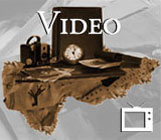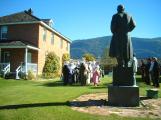1
Where are the Doukhobors today?The Sons of Freedom, the group inclined towards activism, seemed to grow in numbers following the demise of the CCUB. Some of their issues were based on forced assimilation, the province's demands for public schooling, and various other issues in the 40s, 50s and 60s, but since the mid nineteen-seventies, the Sons of Freedom have been relatively inactive.
The Independents in Saskatchewan remained, for the most part, prosperous (as far as farmers go). Some were more inclined than their Community Doukhobor counterparts to get into private business earlier than others, but the Independents are alive and well as most other Doukhobors are today.
4
Today, though still individual, these three factions mingle respectfully and harmoniously with each other - in a united Doukhobor front with one common goal - to promote their ideals of peace and brotherhood of mankind. The Council of Doukhobors in Canada, is a body comprised of members from all factions, uniting as a committee to speak on issues of common concern. It remained as an off-shoot of the Unity Committees which were formed to coordinate and celebrate two recent important centennials, the anniversary of the arms burning of 1895, and the anniversary of 1899 of the immigration of the Doukhobors to Canada.These committees were formed by representatives from all factions of the Doukhobors from all three western provinces and proved that the Doukhobors could work in unity and harmony with each other. This is a continuing, lofty goal which as been set for the Council of Doukhobors in Canada. So far, with such results as the revitalization of the restoration of the Brilliant Suspension Bridge, annual unity meetings in all of the provinces, and other worthy causes, the elusive Doukhobor goal of Toil and Peaceful Life has been facing the challenging times with a united front.
5
Castlegar mayor, Mike O'Connor interview part 1February 2005
Ooteshenie, BC, Canada
 Credits:
Credits:Alex Konkin, interviewer
6
Where are the Doukhobors today? Everywhere.Today, they are doctors, lawyers, painters, carpenters, grounds keepers, artists, mechanics, electricians, nurses, writers, musicians, computer technicians, waitresses and waiters and just as surely as people with other ethnic backgrounds, some must be unemployed. They are in BC, Alberta, Saskatchewan and other parts of Canada as well. They no longer live in communes, but individually and with families, live all over the world.
(Video Clip - Alex Konkin interviews Castlegar, BC mayor, Mike O'Connor on February 2005 - part 1).
7
Castlegar mayor, Mike O'Connor interview part 216 September 2004
Ooteshenie, BC, Canada
 Credits:
Credits:Alex Konkin, interviewer
8
Many of the Doukhobors' accomplishments - arts, crafts, music, and other - are today very much a part of the Canadian mosaic. Peter V. Verigin's home in Verigin, Saskatchewan is both a museum and a National Heritage Site.The Brilliant Suspension Bridge is now a National Heritage Site and plans are underway to make it into a walking bridge and regional park. And never a World Expo happens without a Doukhobor Choir asked to sing to the world. But perhaps one of the finest contributions the Doukhobors have given not only Canada, but the world, would be Borsch and Pyrahi!
(Video Clip - Alex Konkin interviews Castlegar, BC mayor, Mike O'Connor on February 2005 - part 2).
9
The Doukhobor Village Museum:The Brochure states: "The Doukhobor Village Museum is a complete village representing one of the 90 such villages that were located in Kootenay-Boundary region. The Village will transport you back to this simple and benign culture. You will view the famous bread baking oven (petch) and the steam sauna (banya), handmade tools, linen and hemp clothing, all set in a typical village consisting of ten buildings. You will absorb the peaceful tranquillity of an of an unencumbered, holistic lifestyle, as lived in simpler times". In this case the brochure-hype is quite true.
11
By the 1960s, many Kootenay residents noticed that the villages were disappearing as they were purchased for individual dwellings and building materials, others destroyed by arson, artifacts were disappearing funneled across the continent by voracious collectors. Several concerned citizens realized that they would have to move quickly if any remnant or record of this lifestyle could be preserved for future generations.14
By the time the Kootenay Doukhobor Historical Society was formed in 1966, there was not a complete village in sound condition left suitable for a museum. The society listed among its projects; 'The building of a communal house as the first stage in the reconstruction of a complete village'. This premise was adopted as a Castlegar-Kinnaird BC Centennial '71 project, 1971 marking the Centennial of the province of British Columbia.Since its inception, the KDHS has created a unique tourist destination not only for British Columbia, but for the world at large, as a window to the vibrant Doukhobor culture of Canada as well as its links to its Russian ancestry. The last major construction took place in 1995, with the assistance of an Infrastructure Grant, which provided a modern water system and the basic completion of the Village buildings.
The Doukhobor Village Museum continues to provide a community, educational and tourist resource for the local residents and global travelers. Through word-of-mouth advertising, and promotion including a significant Internet presence, and frequent appearances in film documentaries, the Doukhobor Village Museum has attracted worldwide attention. The guest book includes visitors from Russia, Kazakhstan, Alberta, BC, Quebec, Oregon, Washington, England, Ontario, Texas, Germany, Montana, Australia, Austria, Wisconsin, Holland, Idaho, Switzerland, Minnesota, California, Belgium, South Carolina, Scotland, Hawaii, Italy, New Zealand, Sweden, France, Ireland, and Norway, a total of 73 other worldly points of origin to date.




